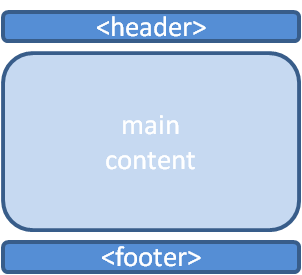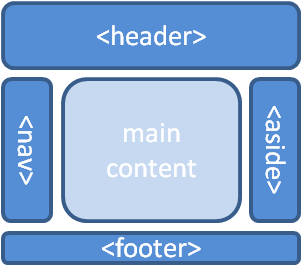CSS layout I
Derek Bridge
Department of Computer Science,
University College Cork
CSS layout I
Aims:
- to learn the difference between fixed-width, elastic and liquid layouts
- to learn how to use CSS to achieve a two-column, fixed-width layout
- to learn how to use CSS to achieve a three-column, fixed-width layout
Single column layout - centred
- Consider a page with a
header, adivwithid="main", and afooter:
- We need to set their width if we are to center them
- Three options
- fixed-width layout
- elastic layout
- liquid layout
Single column layout - centred - fixed-width
- Rigid: they don't change size
- Pro: consistent look
- Con: some visitors will see acres of space or horizontal scrollbars
- Use:
- when you know width of majority of your visitors' windows
- your site has lots of fixed-width content, e.g. images
- pixel-perfect appearance is paramount to you
- How: set widths using pixels
header, #main, footer { margin-left: auto; margin-right: auto; width: 760px; } - What width? 720-960px?
Single column layout - centred - elastic
- Adapts to user's text size, so you keep same number of characters on each line
- Pro: optimize readability
- Con: some visitors will see acres of space or horizontal scrollbars
- Use: when you have lots of text in which typography is important or tables of data
- How: set widths using ems (roughly!!!! one em is two characters in width)
header, #main, footer { margin-left: auto; margin-right: auto; width: 42em; } - What width? Research is inconclusive: 36-96 characters, so 18-48ems?
Single column layout - centred - liquid
- Adapt to user's viewport
- Pro: respect user's preferences and tries to make best use of the space
- Con: hardest to get right, esp. when there are images, etc.
- Use: most of the time
- How: set widths using percentages - these are interpreted relative to container
header, #main, footer { margin-left: auto; margin-right: auto; width: 76%; } - What width? 60-90%?
Multi-column layout
- Multi-column layout (e.g. two or three columns) is very popular
- Older web sites use tables for layout: don't!
- Newer web sites use either CSS positioning properties or floating (becoming the more popular)
- Common layouts are
- two- (or three-) column, fixed-width layout
- two- (or three-) column, liquid layout
Floating an image
- Consider, e.g.:
img { float: left; } - This moves the image to the left edge of its container, with other content moving up to occupy space to the right
- This relies on the floated element being narrower than its container — otherwise there'll be no space to the right
- You can stop the next element from moving up, i.e. so it appears below the floated element
- E.g. if the next element has
id="next":#next { clear: left; } - You could float a logo so that an
hgroupappears alongside it in aheader
Two-column layout - fixed-width

- Make sure the HTML source is in a logical order:
navbefore#main, or#mainbeforenav?- This helps visitors who are not seeing the effects of the CSS. Who in particular?
- If
navbefore#main, then floatnavleft and let#mainmove up - If
#mainbeforenav, then float#mainright and letnavmove up - In either case, force the
footerto sit below by clearing floats - But, if non-floated is longer than floated, non-floated will wrap under floated: so set a margin on non-floated —on the same side and of the same width as the floated
Two-column layout - fixed-width
Here's the CSS assuming nav comes before #main:
nav
{
float: left;
width: 152px;
}
#main
{
margin-left: 152px;
}
footer
{
clear: both;
}
You can increase #main's left margin to give a gap between the two columns.
Two-column layout - centred - fixed-width
- The easiest way to center it is to add a wrapper
divto the HTML, around all the content:<body> <div id="wrapper"> …everything else here… </div> </body> - Then we can centre the wrapper
div:#wrapper { margin-left: auto; margin-right: auto; width: 760px; } - The extra
divis useful in other ways too. What?
Three-column layout - centred - fixed-width

- Make sure the HTML source is in a logical order
- Keep in mind: the one that comes last is the one that moves up
- E.g. assume
nav, then#main, thenasideis the logical order- Float the
navleft; float#mainleft; let theasidemove up - (Alternatively, floating all three left works — esp. for fixed-width layouts)
- Float the
- E.g. assume
nav, thenaside, then#mainis the logical order- Float the
navleft; float theasideright; let#mainmove up
- Float the
- E.g. assume
#main, thennav, thenasideis the logical order- Problem!
- Put another
divaround#mainandnav; float this newdivleft; let theasidemove up; and float#mainright; and remember margins on non-floateds - Or: read-up on approaches that use negative margins
- Clear floats from the footer, as before
- Set margins on non-floated content, as before
- Centre the wrapper
div, as before
Three-column layout - centred - fixed-width
Assuming nav, then #main, then aside is the logical order
#wrapper
{
margin-left: auto;
margin-right: auto;
width: 760px;
}
nav
{
float: left;
width: 152px;
}
#main
{
float: left;
width: 418px;
}
aside
{
margin-left: 570px;
}
footer
{
clear: both;
}